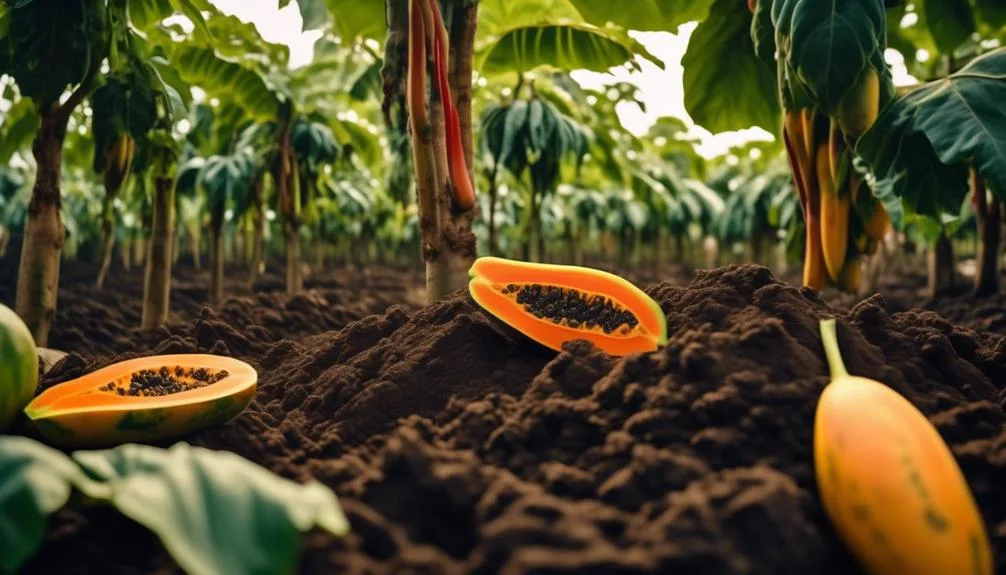To help your papaya trees grow strong and produce lots of delicious fruit, it's important to choose the right fertilizer. The right ingredients can make a big difference in the health of your papaya trees, with vibrant leaves and juicy fruits.
So, what exactly should you look for in a fertilizer for your papaya trees? Let's explore the key ingredients that will help your papaya trees thrive and flourish.
Key Takeaways
- Conduct a soil test to determine existing nutrient levels and choose a balanced NPK fertilizer with a ratio of 10-5-10 or 8-4-8 to ensure the papaya trees receive necessary nutrients for growth and fruit production.
- Utilize organic compost and well-aged manure to improve soil fertility and provide vital nutrients and beneficial microorganisms.
- Incorporate micronutrient-rich fertilizers to address specific deficiencies and promote optimal growth and development of papaya trees.
- Consider using slow-release fertilizers, liquid fertilizers, and foliar feeding techniques to ensure a steady and consistent nutrient supply, promote better nutrient absorption, and enhance the overall health and productivity of papaya trees.
Balanced NPK Fertilizers
To ensure healthy growth, use balanced NPK fertilizers to provide the essential nutrients your papaya trees need.
Start by conducting a soil test to determine the existing nutrient levels in the soil. This will help you choose the right balanced fertilizer that meets the specific needs of your papaya trees.
After analyzing the soil, select a balanced NPK fertilizer with a ratio of 10-5-10 or 8-4-8, ensuring it contains essential nutrients like nitrogen, phosphorus, and potassium.
When applying the fertilizer, use techniques such as broadcasting or banding. Broadcasting involves spreading the fertilizer uniformly over the soil surface, while banding places the fertilizer in a concentrated band along the tree's drip line.
These application techniques help ensure that the papaya trees receive the necessary nutrients for healthy growth and fruit production.
Organic Compost and Manure
Looking to enhance the soil fertility for your papaya trees? Consider utilizing organic compost and manure to provide essential nutrients for healthy growth and fruit production. Organic compost is a rich source of vital nutrients and beneficial microorganisms, improving soil structure and water retention. When it comes to manure, quality is key. Ensure that the manure is well-aged to prevent burning the roots of the papaya tree. Additionally, consider the source of the manure to avoid potential herbicide or pesticide residues. To create your own organic compost, consider layering green and brown materials, such as kitchen scraps, leaves, and grass clippings, and aerating the pile regularly. Proper composting techniques will ensure a nutrient-rich soil amendment for your papaya trees.
| Composting Techniques | Manure Quality |
|---|---|
| Layering green and brown materials | Well-aged |
| Regular aeration | Consider the source |
Micronutrient-Rich Fertilizers
Consider incorporating micronutrient-rich fertilizers to provide essential nutrients for the optimal growth and development of your papaya trees. Soil pH management is crucial for ensuring the availability of micronutrients to the plants. Micronutrient deficiencies, such as iron and zinc, can significantly impact the health and yield of papaya trees.
When choosing a micronutrient-rich fertilizer, consider its compatibility with the soil pH and the specific deficiencies identified. Fertilizer application techniques play a vital role in ensuring nutrient uptake efficiency. Foliar application of micronutrient-rich fertilizers can be particularly effective in addressing immediate nutrient deficiencies.
Additionally, incorporating micronutrient-rich fertilizers into the soil during planting or through regular root application can provide long-term benefits to the papaya trees. By carefully managing micronutrient levels, you can ensure the overall health and productivity of your papaya trees.
Slow-Release Fertilizers
You can enhance the nutrient supply to your papaya trees by utilizing slow-release fertilizers, which provide a steady and consistent source of essential nutrients over an extended period of time. These fertilizers are designed to break down gradually, ensuring that your papaya trees receive a continuous flow of nutrients for optimal growth and fruit production.
Here are some key points to consider when using slow-release fertilizers:
- Application frequency: Slow-release fertilizers typically require less frequent application compared to traditional fertilizers, as they slowly release nutrients over an extended period.
- Nutrient absorption: These fertilizers promote better nutrient absorption by releasing nutrients in sync with the papaya tree's growth stages, ensuring that the tree can effectively uptake and utilize the essential elements.
Liquid Fertilizers and Foliar Feeding
Slow-release fertilizers provide a consistent nutrient supply for papaya trees.
Now let's explore the benefits of liquid fertilizers and foliar feeding for further enhancing their health and productivity.
Liquid fertilizers are highly effective due to their quick absorption by the papaya tree's root system, delivering essential nutrients directly to where they're needed most. This can lead to rapid growth, lush foliage, and increased fruit production.
Additionally, the feasibility of foliar feeding, where nutrients are absorbed through the leaves, is worth considering. It offers a way to address nutrient deficiencies quickly and efficiently. Foliar feeding can be especially beneficial during periods of rapid growth or when the papaya tree is under stress.
When used in conjunction with a well-balanced soil fertilizer program, liquid fertilizers and foliar feeding can significantly contribute to the overall health and vitality of papaya trees.
Conclusion
In nurturing your papaya trees with the best fertilizers, you're setting the stage for a bountiful harvest of delicious, juicy fruit. Whether through balanced NPK fertilizers, organic compost and manure, micronutrient-rich fertilizers, slow-release fertilizers, or liquid fertilizers and foliar feeding, you're ensuring the well-being of your trees for years to come.
Keep tending to them with care, and they'll continue to reward you with an abundance of sweet papayas.
Happy gardening!

